The MSI X299 XPower Gaming AC Review: Flagship Fantasy
by Joe Shields on May 9, 2018 8:00 AM EST- Posted in
- Motherboards
- Intel
- MSI
- X299
- Basin Falls
- Skylake-X
- i9-7900X
CPU Performance, Short Form
For our motherboard reviews, we use our short form testing method. These tests usually focus on if a motherboard is using MultiCore Turbo (the feature used to have maximum turbo on at all times, giving a frequency advantage), or if there are slight gains to be had from tweaking the firmware. We leave the BIOS settings at default and memory at JEDEC for the supported frequency of the processor for these tests, making it very easy to see which motherboards have MCT enabled by default.
Rendering - Blender 2.78: link
For a render that has been around for what seems like ages, Blender is still a highly popular tool. We managed to wrap up a standard workload into the February 5 nightly build of Blender and measure the time it takes to render the first frame of the scene. Being one of the bigger open source tools out there, it means both AMD and Intel work actively to help improve the codebase, for better or for worse on their own/each other's microarchitecture.
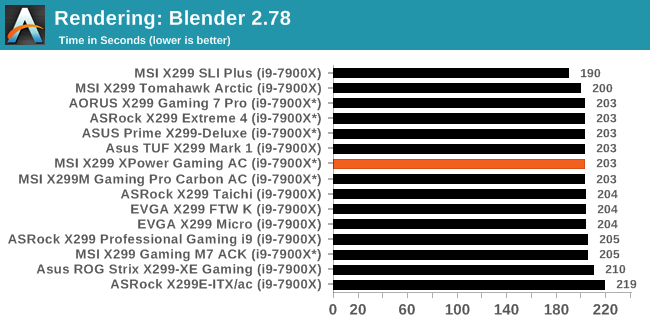
In the Blender testing, the MSI X299 completed the benchmark in 203 seconds which puts it towards the top third of results and in the middle of a tight group of results. The vast majority of boards run this benchmark and behave similarly.
Rendering – POV-Ray 3.7: link
The Persistence of Vision Ray Tracer, or POV-Ray, is a freeware package for as the name suggests, ray tracing. It is a pure renderer, rather than modeling software, but the latest beta version contains a handy benchmark for stressing all processing threads on a platform. We have been using this test in motherboard reviews to test memory stability at various CPU speeds to good effect – if it passes the test, the IMC in the CPU is stable for a given CPU speed. As a CPU test, it runs for approximately 1-2 minutes on high-end platforms.
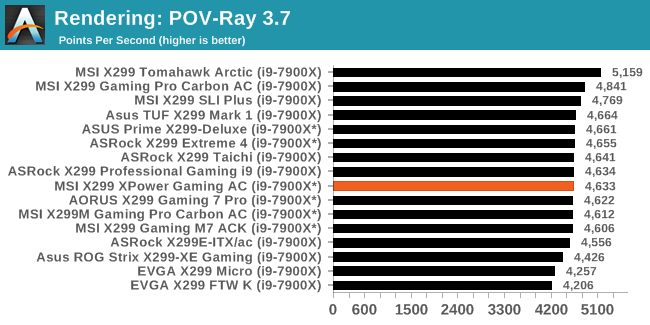
For our POV-Ray results, the Gaming XPower Gaming AC lands middle of results scoring 4,633. POV-Ray is sensitive to frequency with boards making the most of an MCE implementation leading the pack.
Compression – WinRAR 5.4: link
Our WinRAR test from 2013 is updated to the latest version of WinRAR at the start of 2014. We compress a set of 2867 files across 320 folders totaling 1.52 GB in size – 95% of these files are small typical website files, and the rest (90% of the size) are small 30-second 720p videos.
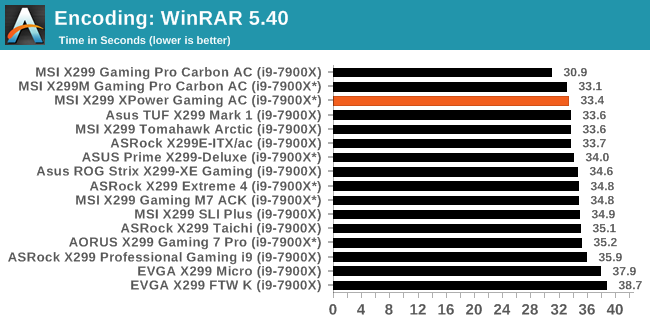
WinRAR data places the X299 Gaming Pro Carbon AC second at 33.4 seconds which is one of the faster results we have seen. All MSI boards, in general did quite well in this test. The MCE implementations on some MSI boards are more aggressive than others.
Synthetic – 7-Zip 9.2: link
As an open source compression tool, 7-Zip is a popular tool for making sets of files easier to handle and transfer. The software offers up its own benchmark, to which we report the result.
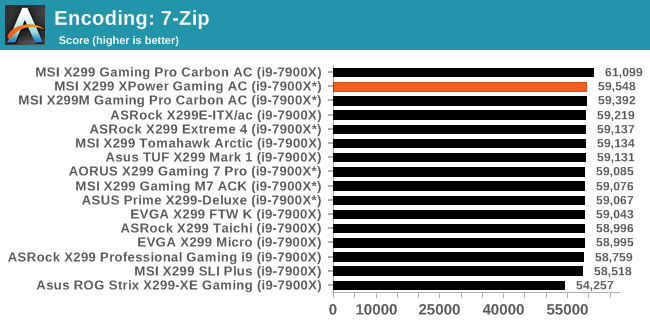
Our 7-Zip results are similar here with the XPower Gaming AC posting the second highest result on our testing. Here again, MSI's aggressive MCE has their boards rising to the top. Though again, all of these results are extremely close with only two results notably better or worse than the rest. As is typical, the board here ran the test at 4.0 GHz.
Point Calculations – 3D Movement Algorithm Test: link
3DPM is a self-penned benchmark, taking basic 3D movement algorithms used in Brownian Motion simulations and testing them for speed. High floating point performance, MHz, and IPC win in the single thread version, whereas the multithread version has to handle the threads and loves more cores. For a brief explanation of the platform agnostic coding behind this benchmark, see my forum post here.
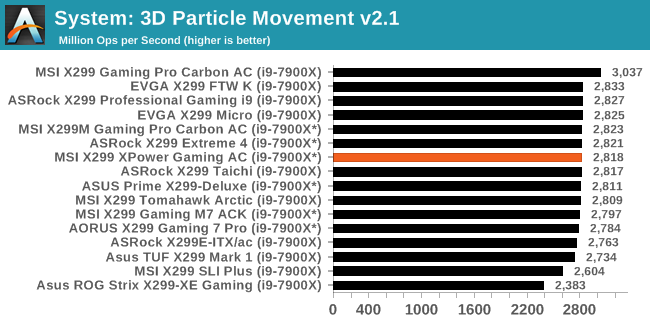
The 3DPM result lands the XPower on the top half of results, still in the middle of the pack. During this test it performs six mini-tests with a 10-second gap between them: our result is a 3.6 GHz CPU clock speed during the test as are most from this set of results.
Neuron Simulation - DigiCortex v1.20: link
The newest benchmark in our suite is DigiCortex, a simulation of biologically plausible neural network circuits, and simulates activity of neurons and synapses. DigiCortex relies heavily on a mix of DRAM speed and computational throughput, indicating that systems which apply memory profiles properly should benefit and those that play fast and loose with overclocking settings might get some extra speed up. Results are taken during the steady state period in a 32k neuron simulation and represented as a function of the ability to simulate in real time (1.000x equals real-time).
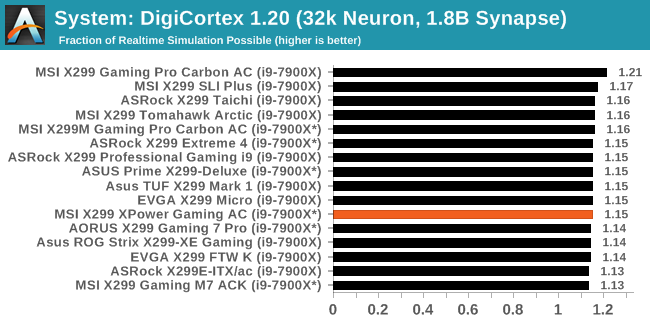
In the DigiCortex testing, this MSI board managed a middling result.










17 Comments
View All Comments
BPB - Wednesday, May 9, 2018 - link
Sigh, I guess I can always dream about owning such an expensive board. But I can't imagine anybody who is budget conscious or not rich buying one. I wonder how MSI and the others sell enough boards like this to justify making them.Achaios - Wednesday, May 9, 2018 - link
Unfortunately, the era of me dreaming of motherboards and CPU's passed long ago with no signs of returning. Nowadays, the only thing I usually dream of is East Asian fleshpots and lots and lots of ambitious girls in, out, on top and below. Do I miss the time my only interest in the world was my Pentium 4, my NVIDIA GO GPU with 128 megs of RAM and World of Warcraft? Sometimes yes but not really.WinterCharm - Wednesday, May 9, 2018 - link
Hands down the funniest comment I’ve read on here in a long time :)Ket_MANIAC - Wednesday, May 9, 2018 - link
And another great X299 review. Expecting at least a dozen more such reviews and expecting no review for any AM4 boards or X470 boards at all because who buys cheap stuff. Come on guys, is it really that hard? People already blame you guys to being Intel shills and all and reviews such as these only add fuel to their talk. Not that the review is bad but what reason could you have for this megaload of X299 reviews?rsandru - Wednesday, May 9, 2018 - link
Agreed, X299 is going to be replaced soon anyway so even for potential Intel HEDT buyers all those motherboards are most likely non starters... And this one still sports the tiny VRM heat sink that was repeatedly pointed out as being insufficient.To round this perfectly marketed product there’s the ‘gaming’ in the name, as if anyone whose main interest is playing games would pick an X299 platform over a Z370.
Peter2k - Wednesday, May 9, 2018 - link
You'd be surprised how many gamers where absolutely convinced they need quad channel and a bazillion pcie-x lanes for that sweet sweet quad GPU setup they gonna have one day so that they don't throttle when using many M2 SSD'sMarketing must be doing a great job these days
Surprisingly it's the sort of same amount of gamers that don't know that quad GPU setups are dead
Quad channel doesn't do anything for gaming (or most use cases anyway)
Ehh
As long as there are LED's on it
Ket_MANIAC - Thursday, May 10, 2018 - link
What I am baffled about is the lack of AM4 motherboard reviews from AnandTech. They are one of the few publications out here who do motherboard reviews right and just 6 reviews in over a year, out of which 3 are boards that no body ever buys when talking about AM4. Yes, they have covered a lot of Ryzen stuff lately. And motherboard reviews are generally not as important as CPU. But if that's the case, how do you justify "16" X299 reviews? And no X399? I might be coming of as an AMD fanboy, so hold your horses. I am an AMD fan. Not a fanboy. It doesn't take an Einstein to know which among the X299 and AM4 is more important and which among the X299 and X399 is more successful.DanNeely - Thursday, May 10, 2018 - link
Mobo Reviewer A is doing all of the x299 boards in a single giant batch.Mobo Reviewer B is doing all of the AM4 boards in a single giant batch.
The selection of boards they get to review come down to what manufactures send as press samples. There're enough of those to keep all the reviewers busy full time so Anandtech rarely if ever buys retail boards to review.
There currently isn't an active Mobo Reviewer C, so any x399 samples that've been sent in are waiting until A or B clears his current backlog; or one of the other contributors clears out the backlog of what they're currently working on and can step in on mobos again. (eg E. Fylladitakis did a batch of mobos last summer between his keyboard and PSU reviews.)
Ket_MANIAC - Thursday, May 10, 2018 - link
Quite alright but doesn't 16 X299 reviews seem to you as pointless? I don't know if you are representing Anandtech but if you are, don't you think more AM4 stuff would bring more readership to your website? You guys have the power to choose which boards you review among the ones that manufacturers send you and I don't think it is possible that Asus has never sent the Crosshair VI Hero or the VII Hero to you(from the CPU review, I see they had), ASRock never sent the X370 Taichi to you. Wouldn't reviewing these boards make more sense right now considering the 2000 series just launched?PeachNCream - Wednesday, May 9, 2018 - link
It's another X299 MSI motherboard review, because we really need to hear more about MSI products since there are no other vendors out there that produce computer parts.